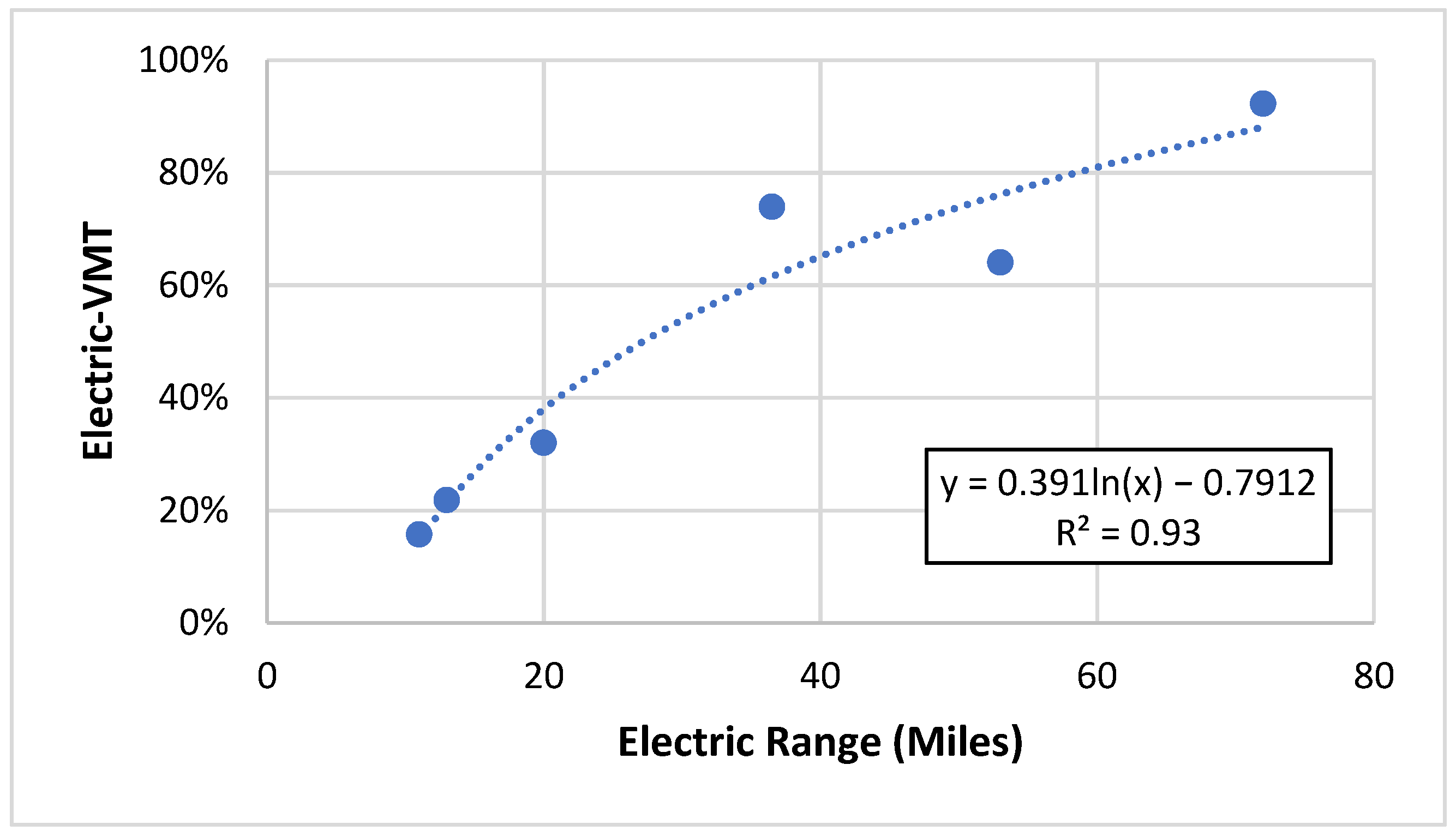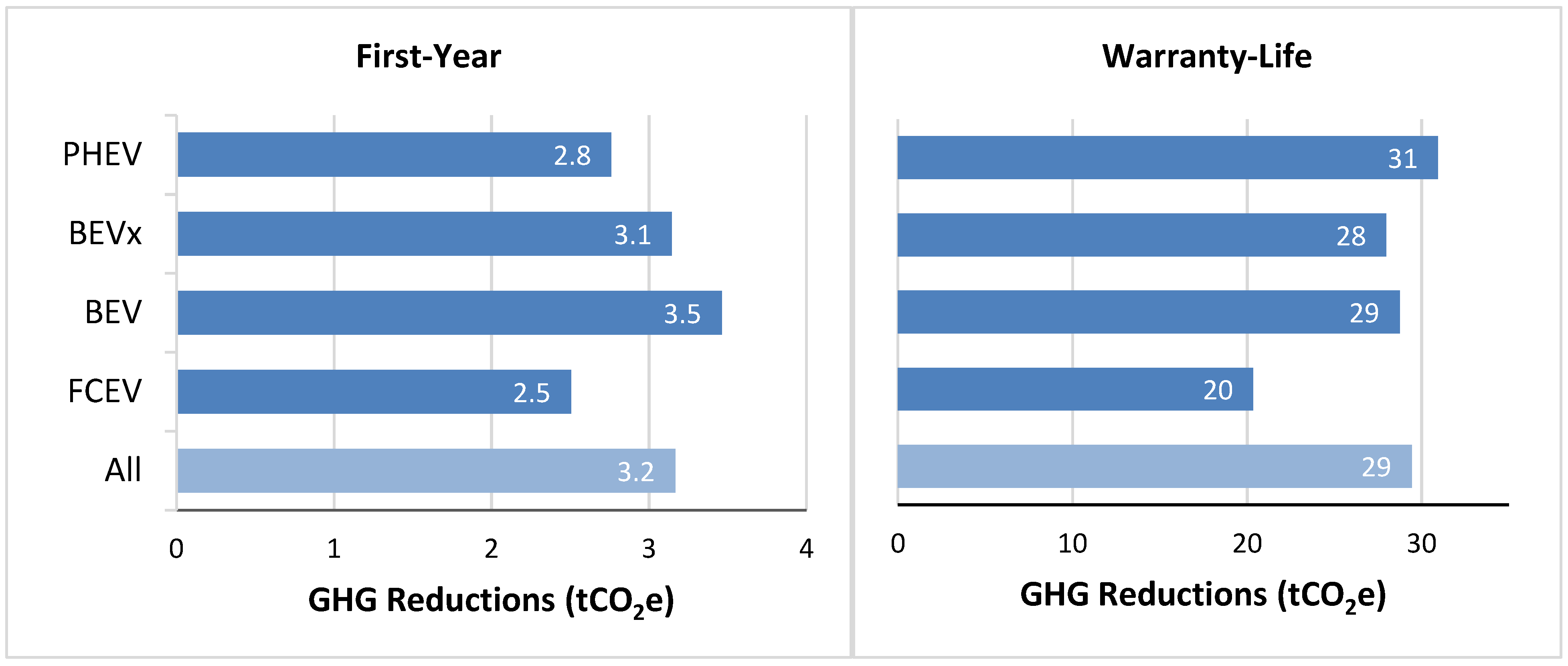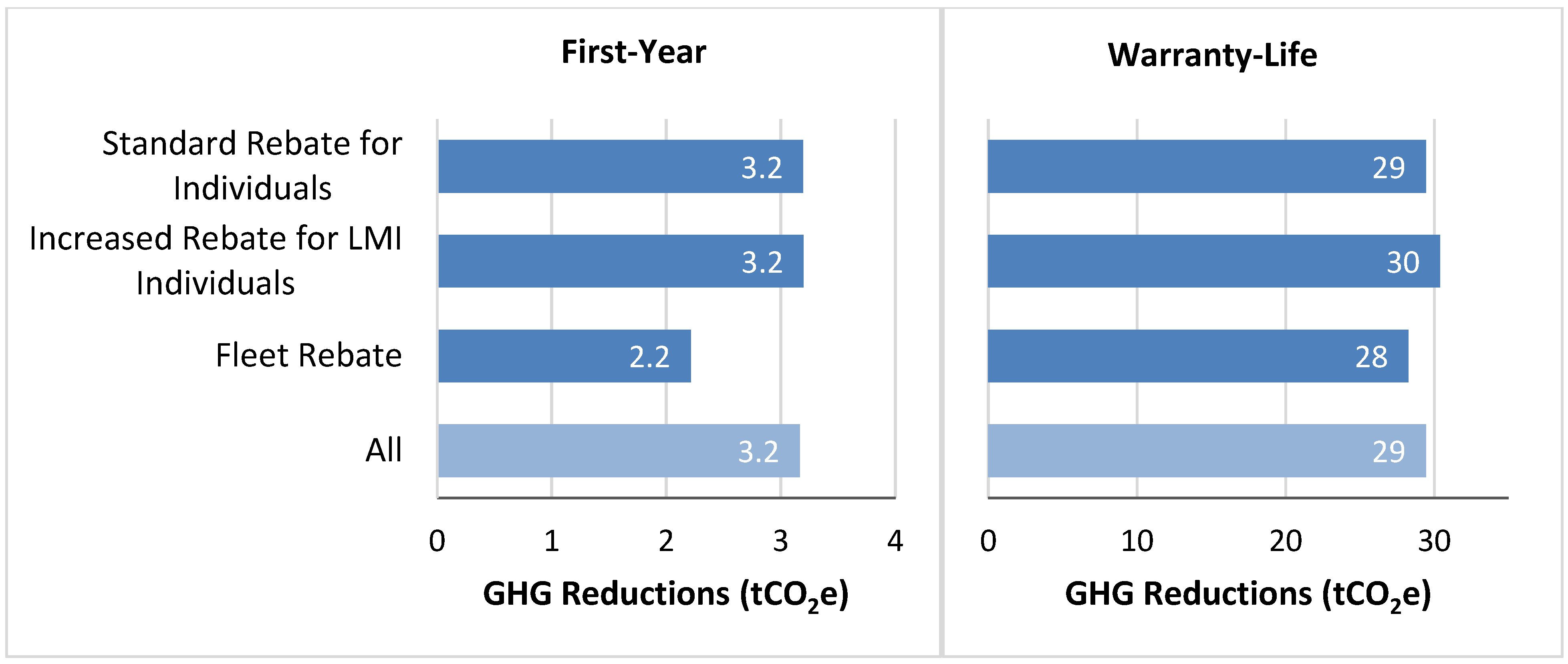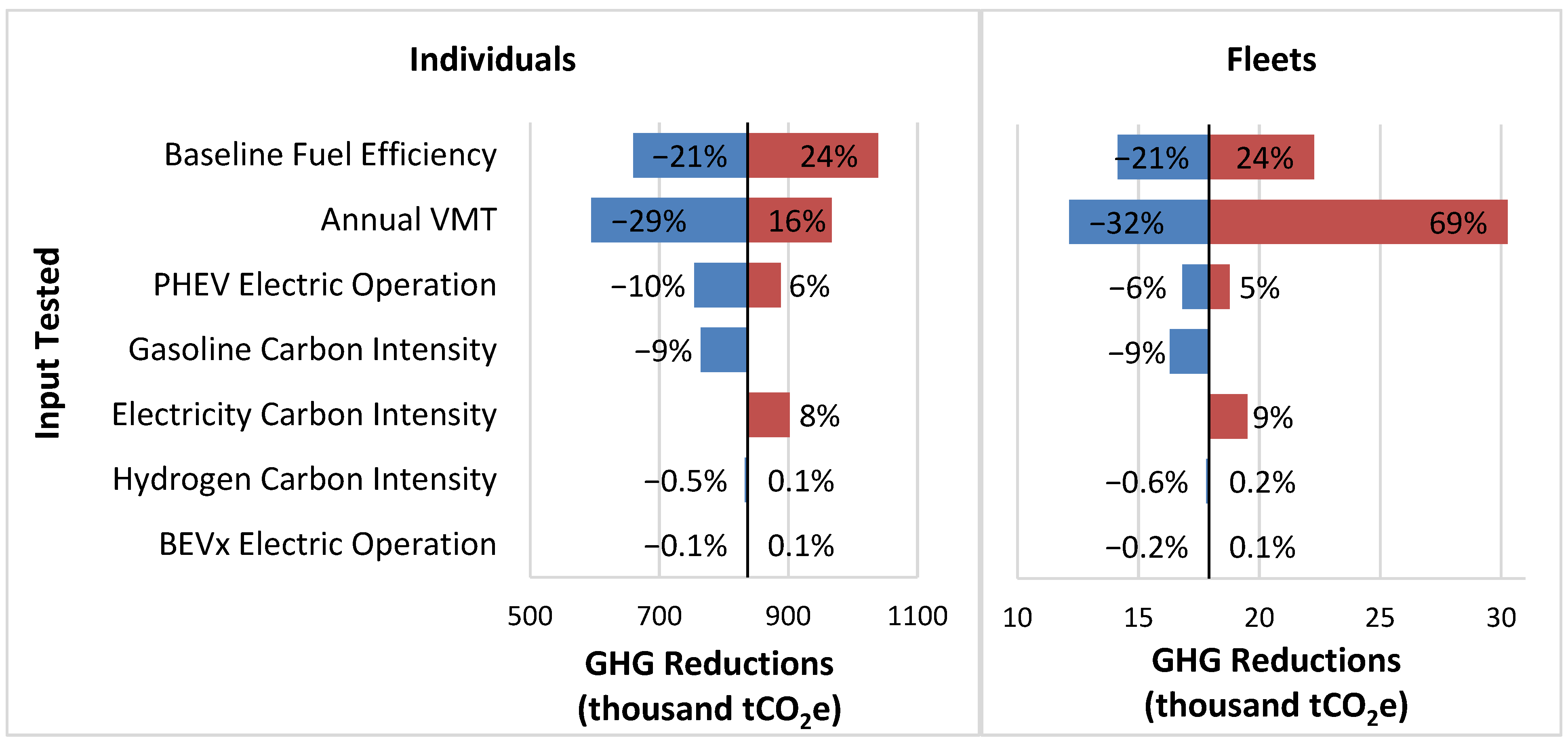Refining Estimates of Fuel-Cycle Greenhouse-Gas Emission Reductions Associated with California’s Clean Vehicle Rebate Project with Program Data and Other Case-Specific Inputs
Abstract
:1. Introduction
1.1. Motivation
1.2. Previous Related Work
1.3. Contribution and Overview
- It extends the perspective from annual reporting towards a “life-of-project” view, examining emission reductions from CVRP’s inception in 2010 through the end of August 2018. (The end of the date range reflects the most recent data available for this use at the time of the analysis; subsequent work in progress will incorporate more recent data and select other features described in Section 4.2.)
- It incorporates project-derived and/or case-specific data. Specifically, it employs model- and model-year-specific fuel consumption rate values corresponding to the nearly 270,000 vehicles rebated, as well as model-specific electric-VMT values corresponding to over 100,000 rebated PHEVs. California-sales-weighted average fuel consumption rate values were created for each model year of baseline gasoline vehicles for comparison.
- It includes an initial quantification of GHG savings from rebated fuel-cell electric vehicles (FCEVs).
- It assesses how emissions vary by rebate type and consumer type.
- It analyzes the sensitivity of the results to variations in individual input values.
2. Materials and Methods
2.1. Data Summary
2.1.1. Application Data
2.1.2. Survey Data
2.1.3. Vehicle Registration Data
2.2. Methods and Inputs
2.2.1. Rebated Emission Reductions: Approach
2.2.2. Rebated Emission Reductions: Operation Lifetime Assumption
2.2.3. Rebate-Essential Emission Reductions
3. Results
3.1. GHG Emission Reduction Estimates
3.2. GHG Sensitivity Analysis
3.2.1. Sensitivity to Baseline-Vehicle Fuel Consumption Rates
3.2.2. Sensitivity to Annual Vehicle Miles Traveled
3.2.3. Sensitivity to Electric-VMT Percentage
3.2.4. Sensitivity to Carbon Intensity of Fuels
3.2.5. Sensitivity to Rebate Essentiality
3.2.6. Operation Lifetime
4. Discussion
4.1. Impact of Methodological Contributions
4.2. Limitations and Next Steps
4.2.1. Project Eligibility Changes and Extrapolation of Results to Future Time Periods
4.2.2. Additional Project Data to Utilize
4.2.3. Conservatisms to Address and Other Considerations
5. Conclusions
Author Contributions
Funding
Informed Consent Statement
Data Availability Statement
Acknowledgments
Conflicts of Interest
Abbreviations
| BEV | battery-electric vehicle |
| BEVx | range-extended battery-electric vehicle |
| CA | California |
| CARB | California Air Resources Board |
| CI | carbon intensity |
| CO2e | carbon dioxide-equivalent |
| CVRP | Clean Vehicle Rebate Project |
| EPA | Environmental Protection Agency |
| EV | electric vehicle |
| FCEV | fuel-cell electric vehicle |
| g | gram |
| gal | gallon |
| GHG | greenhouse-gas |
| hwy | highway |
| kg | kilogram |
| kWh | kilowatt-hour |
| LCA | life-cycle assessment |
| LCFS | Low Carbon Fuel Standard |
| LDV | light-duty vehicle |
| LMI | low-/moderate-income |
| MPG | miles per gallon |
| MY | model year |
| PHEV | plug-in hybrid electric vehicle |
| RPS | renewable portfolio standard |
| tCO2e | metric tons of carbon dioxide-equivalent |
| VMT | vehicle miles traveled |
Appendix A
| Model Year | Baseline Vehicle | U.S.-Production-Weighted Avg. Fuel Economy [31,37] | ||||
|---|---|---|---|---|---|---|
| Fuel Economy (MPG) | Description | Car | Car and Truck | |||
| Value (MPG) | Diff. from Baseline | Value (MPG) | Diff. from Baseline | |||
| 2009 | 25.4 | U.S.-production-weighted avg. (car) [31] | 25.4 | n.a. | 22.4 | −12% |
| 2010 | 25.8 | 25.8 | n.a. | 22.6 | −12% | |
| 2011 | 25.1 | CA-sales-weighted avg. for the 30 top-selling new gasoline models (calculations using data from [21,30]) | 25.4 | 1% | 22.3 | −11% |
| 2012 | 27.9 | 26.9 | −3% | 23.6 | −15% | |
| 2013 | 27.9 | 27.7 | −1% | 24.2 | −13% | |
| 2014 | 28.2 | 27.6 | −2% | 24.1 | −15% | |
| 2015 | 28.4 | 28.2 | −1% | 24.6 | −13% | |
| 2016 | 28.7 | 28.5 | −1% | 24.7 | −14% | |
| 2017 | 28.0 | 29.2 | 4% | 25.2 | −11% | |
| 2018 | 28.8 | 29.9 | 4% | 25.4 | −12% | |
| 2019 1 | 28.8 | - | - | - | - | |
Appendix B
| Technology Type | Fleets | Individuals | |
|---|---|---|---|
| Annual VMT | Description | Annual VMT | |
| PHEV | 7768 | Average of FY 2013–2017 federal fleet passenger vehicle annual VMT in [24] | 13,472 |
| BEVx, Short Range BEV | 11,366 | Fleet PHEV VMT decreased by the magnitude observed for individuals: | 11,366 |
| Long Range BEV | 9196 | Fleet PHEV VMT decreased by the magnitude observed for individuals: | 13,456 |
| FCEV | 13,456 | Fleet PHEV VMT decreased by the magnitude observed for individuals: | 12,445 |
Appendix C

Appendix D
| Technology Type | 2013–15 Edition | 2015–16 Edition | 2016–17 Edition |
|---|---|---|---|
| PHEV | 41% | 47% | 47% |
| BEV/BEVx | 50% | 61% | 64% |
| FCEV | n.a. | n.a. | 67% |
Appendix E
| Technology Type | Total Rebated Reductions thousand tCO2e) | Per-Vehicle Reductions (tCO2e) | Total Rebate-Essential Reductions (Individuals only, thousand tCO2e) |
|---|---|---|---|
| PHEV( N = 104,583) | Y1 = 289 WL = 3235 | Y1 = 2.8 WL = 31 | Y1 = 127 (45%) WL = 1418 (45%) |
| BEVx (N = 6559) | Y1 = 21 WL = 183 | Y1 = 3.1 WL = 28 | Y1 = 12 (61%) WL = 107 (61%) |
| BEV (N = 154,184) | Y1 = 534 WL = 4432 | Y1 = 3.5 WL = 29 | Y1 = 301 (58%) WL = 2471 (58%) |
| FCEV (N = 4576) | Y1 = 11 WL = 93 | Y1 = 2.5 WL = 20 | Y1 = 8 (67%) WL = 60 (67%) |
| All (N = 269,902) | Y1 = 855 WL = 7944 | Y1 = 3.2 WL = 29 | Y1 = 448 (54%) WL = 4057 (53%) |
| Technology Type | Total Rebated Reductions (thousand tCO2e) | Per-Vehicle Reductions (tCO2e) | Total Rebate-Essential Reductions (Individuals Only, Thousand tCO2e) |
|---|---|---|---|
| Standard Rebatefor Individuals (N = 251,960) | Y1 = 805 WL = 7416 | Y1 = 3.2 WL = 29 | Y1 = 429 (53%) WL = 3885 (52%) |
| Low-/Moderate-Income Increased Rebate for Individuals (N = 9859) | Y1 = 32 WL = 300 | Y1 = 3.2 WL = 30 | Y1 = 18 (59%) WL = 172 (57%) |
| Fleet Rebate (N = 8083) | Y1 = 18 WL = 228 | Y1 = 2.2 WL = 28 | n.a. |
| All (N = 269,902) | Y1 = 855 WL = 7944 | Y1 = 3.2 WL = 29 | Y1 = 448 (54%) WL = 4057 (53%) |
References
- Nealer, R.; Hendrickson, T.P. Review of Recent Lifecycle Assessments of Energy and Greenhouse Gas Emissions for Electric Vehicles. Curr. Sustain. Renew. Energy Rep. 2015, 2, 66–73. [Google Scholar] [CrossRef] [Green Version]
- Marmiroli, B.; Messagie, M.; Dotelli, G.; Van Mierlo, J. Electricity generation in LCA of electric vehicles: A review. Appl. Sci. 2018, 8, 1384. [Google Scholar] [CrossRef] [Green Version]
- Lattanzio, R.K.; Clark, C.E. Environmental Effects of Battery Electric and Internal Combustion Engine Vehicles; Congressional Research Service: Washington, DC, USA, 2020.
- National Research Council. Transitions to Alternative Vehicles and Fuels; National Academies Press: Washington, DC, USA, 2013. [Google Scholar] [CrossRef]
- Babaee, S.; Nagpure, A.S.; Decarolis, J.F. How much do electric drive vehicles matter to future U.S. emissions? Environ. Sci. Technol. 2014, 48, 1382–1390. [Google Scholar] [CrossRef]
- Archsmith, J.; Kendall, A.; Rapson, D. From Cradle to Junkyard: Assessing the Life Cycle Greenhouse Gas Benefits of Electric Vehicles. Res. Transp. Econ. 2015, 52, 72–90. [Google Scholar] [CrossRef] [Green Version]
- Lutsey, N. Global Climate Change Mitigation Potential from a Transition to Electric Vehicles; ICCT: Washington, DC, USA, 2015. [Google Scholar]
- National Academies of Sciences, Engineering, and Medicine. Zero Emission Vehicles: Forecasting Fleet Scenarios and their Emissions Implications; The National Academies Press: Washington, DC, USA, 2019. [Google Scholar] [CrossRef]
- Brown, A.L.; Sperling, D.; Austin, B.; DeShazo, J.; Fulton, L.; Lipman, T.; Murphy, C.; Daniel Saphores, J.; Tal, G. Driving California’s Transportation Emissions to Zero; UC Office of the President: University of California Institute of Transportation Studies: Oakland, CA, USA, 2021. [Google Scholar] [CrossRef]
- Gohlke, D.; Zhou, Y. Assessment of Light-Duty Plug-In Electric Vehicles in the United States, 2010–2019; United States Department of Energy Office of Scientific and Technical Information (OSTI): Oak Ridge, TN, USA, 2020. [CrossRef]
- California Air Resources Board. Proposed Fiscal Year 2017-18 Funding Plan for Clean Transportation Incentives. 2017. Available online: https://ww2.arb.ca.gov/sites/default/files/classic/msprog/aqip/fundplan/proposed_1718_funding_plan_final.pdf (accessed on 30 July 2018).
- California Air Resources Board. EMFAC2014 Web Database. 2014. Available online: https://www.arb.ca.gov/emfac/2014/ (accessed on 30 July 2018).
- California Air Resources Board. LCFS Pathway Certified Carbon Intensities. Available online: https://www.arb.ca.gov/fuels/lcfs/fuelpathways/pathwaytable.htm (accessed on 30 July 2018).
- California Air Resources Board. Low Carbon Fuel Standard Regulation. 2015. Available online: https://www.arb.ca.gov/regact/2015/lcfs2015/lcfsfinalregorder.pdf (accessed on 30 July 2018).
- California Air Resources Board. Proposed Fiscal Year 2016–2017 Funding Plan for Low Carbon Transportation and Fuels Investments and the Air Quality Improvement Program, Appendix A—Emission Reductions: Quantification Methodology. 2016. Available online: https://www.arb.ca.gov/msprog/aqip/fundplan/proposed_fy16-17_fundingplan_appa.pdf (accessed on 30 July 2018).
- Johnson, C.; Williams, B. Characterizing Plug-In Hybrid Electric Vehicle Consumers Most Influenced by California’s Electric Vehicle Rebate. Transp. Res. Rec. 2017, 2628, 23–31. [Google Scholar] [CrossRef]
- Williams, B.; Anderson, J. Strategically Targeting Plug-in Electric Vehicle Rebates and Outreach Using Characteristics of “Rebate-Essential” Consumers in 2016–2017. In Proceedings of the 31st International Electric Vehicles Symposium, Kobe, Japan, 30 September–3 October 2018. [Google Scholar]
- Clean Vehicle Rebate Project. Income Eligibility. Available online: https://cleanvehiclerebate.org/eng/income-eligibility (accessed on 3 December 2020).
- California Air Resources Board. Low Carbon Fuel Standard Regulation. 2018. Available online: https://www.arb.ca.gov/regact/2018/lcfs18/frolcfs.pdf (accessed on 30 May 2019).
- California Air Resources Board. Low Carbon Fuel Standard Annual Updates to Lookup Table Pathways. 2020. Available online: https://ww3.arb.ca.gov/fuels/lcfs/fuelpathways/comments/tier2/elec_update.pdf?_ga=2.23020219.126207149.1587598652-1818811838.1579023467 (accessed on 4 May 2020).
- Fuel Economy Data. United States Department of Energy and United States Environmental Protection Agency. Available online: https://www.fueleconomy.gov/feg/download.shtml (accessed on 30 July 2018).
- Tal, G.; Raghavan, S.S.; Karanam, V.C.; Favetti, M.P.; Sutton, K.M.; Lee, J.H.; Nitta, C.; Kurani, K.; Chakraborty, D.; Michael, N.; et al. Advanced Plug-in Electric Vehicle Travel and Charging Behavior Final Report; California Air Resources Board: Sacramento, CA, USA, 2019. [Google Scholar]
- Hardman, S. Understanding the Early Adopters of Fuel Cell Vehicles; California Department of Transportation: Sacramento, CA, USA, 2019. [CrossRef]
- U.S. General Services Administration. FY 2017 Federal Fleet Report. 2018. Available online: https://www.gsa.gov/policy-regulations/policy/vehicle-management-policy/federal-fleet-report (accessed on 15 March 2019).
- Zero-Emission Vehicle Standards for 2009 through 2017 Model Year Passenger Cars, Light-Duty Trucks, and Medium-Duty Vehicles, 13 CCR § 1962.1. Available online: https://ww2.arb.ca.gov/sites/default/files/2019-07/cleancomplete%20lev-ghg%20regs%2010-19.pdf (accessed on 17 April 2020).
- Zero-Emission Vehicle Standards for 2018 and Subsequent Model Year Passenger Cars, Light-Duty Trucks, and Medium-Duty Vehicles, 13 CCR § 1962.2. Available online: https://ww2.arb.ca.gov/sites/default/files/2019-07/cleancomplete%20lev-ghg%20regs%2010-19.pdf (accessed on 17 April 2020).
- United States Office of Energy Efficiency and Renewable Energy. Electric Car Safety, Maintenance, and Battery Life. Available online: https://www.energy.gov/eere/electricvehicles/electric-car-safety-maintenance-and-battery-life#:~:text=Like%20the%20engines%20in%20conventional,5%20years%20or%2060%2C000%20miles. (accessed on 3 June 2020).
- PluginCars.com. All the News, Reviews, Guides and Reports on Electric Cars. Available online: https://www.plugincars.com/archives (accessed on 15 February 2018).
- Car and Driver. Reviews. Available online: https://www.caranddriver.com/reviews/ (accessed on 15 February 2018).
- Monthly New Vehicle Registration Data. IHS Markit. 2018. Available online: https://ihsmarkit.com/index.html (accessed on 17 September 2018).
- United States Environmental Protection Agency. Light-Duty Automotive Technology, Carbon Dioxide Emissions, and Fuel Economy Trends: 1975 through 2017. 2018. Available online: https://nepis.epa.gov/Exe/ZyPDF.cgi?Dockey=P100TGDW.pdf (accessed on 30 July 2018).
- California Air Resources Board. California’s Advanced Clean Cars Midterm Review, Appendix G: Plug-in Electric Vehicle In-Use and Charging Data Analysis. 2017. Available online: https://ww2.arb.ca.gov/sites/default/files/2020-01/appendix_g_pev_in_use_and_charging_data_analysis_ac.pdf (accessed on 30 July 2018).
- Idaho National Laboratory. Plug-in Electric Vehicle and Infrastructure Analysis. 2015. Available online: https://inldigitallibrary.inl.gov/sites/sti/sti/6799570.pdf (accessed on 30 July 2018).
- Carlson, B. Electric Vehicle Mile Traveled (eVMT): On-Road Results and Analysis. 2015. Available online: http://energy.gov/sites/prod/files/2015/07/f24/vss171_carlson_2015_p.pdf (accessed on 30 July 2018).
- Duhon, A.; Sevel, K.; Tarnowsky, S.; Savagian, P. Chevrolet Volt Electric Utilization. SAE Int. J. Altern. Powertrains 2015, 4, 269–276. [Google Scholar] [CrossRef]
- Boston, D.; Werthman, A. Plug-in Vehicle Behaviors: An analysis of charging and driving behavior of Ford plug-in electric vehicles in the real world. World Electr. Veh. J. 2016, 8, 926–935. [Google Scholar] [CrossRef] [Green Version]
- United States Environmental Protection Agency. Light-Duty Automotive Technology, Carbon Dioxide Emissions, and Fuel Economy Trends: 1975 through 2018. 2019. Available online: https://www.epa.gov/automotive-trends/download-automotive-trends-report#Report-Tables (accessed on 27 August 2019).
- Nicholas, M.A.; Tal, G.; Turrentine, T.S. Advanced Plug-in Electric Vehicle Travel and Charging Behavior Interim Report. 2017. Available online: https://itspubs.ucdavis.edu/index.php/research/publications/publication-detail/?pub_id=2692 (accessed on 30 July 2018).
- United States Environmental Protection Agency. eGRID Summary Tables 2018. 2020. Available online: https://www.epa.gov/sites/production/files/2020-01/documents/egrid2018_summary_tables.pdf (accessed on 1 April 2020).
- California Air Resources Board. Proposed Fiscal Year 2019-20 Funding Plan for Clean Transportation Incentives. 2019. Available online: https://ww2.arb.ca.gov/sites/default/files/2019-09/fy1920fundingplan-appa.pdf (accessed on 4 May 2020).
- National Renewable Energy Laboratory. Predictive Models of Li-Ion Battery Lifetime. 2014. Available online: https://afdc.energy.gov/fuels/electricity_benefits.html (accessed on 4 May 2020).
- Demuro, D. Buying a Car: How Long Can You Expect a Car to Last? 2019. Available online: https://www.autotrader.com/car-shopping/buying-car-how-long-can-you-expect-car-last-240725 (accessed on 4 February 2021).
- Auto Alliance. In Your State: State Facts. Available online: https://autoalliance.org/in-your-state/CA (accessed on 31 March 2020).
- Pallonetti, N.; Williams, B. Exploratory Estimation of Greenhouse-Gas Emission Reductions Associated with California’s Clean Vehicle Rebate Project. In Proceedings of the Transportation Research Board 2019 Annual Meeting, Washington, DC, USA, 13–17 January 2019. [Google Scholar]
- Jenn, A.; Azevedo, I.M.L.; Michalek, J.J. Alternative Fuel Vehicle Adoption Increases Fleet Gasoline Consumption and Greenhouse Gas Emissions under United States Corporate Average Fuel Economy Policy and Greenhouse Gas Emissions Standards. Environ. Sci. Technol. 2016, 50, 2165–2174. [Google Scholar] [CrossRef] [PubMed]
- Williams, B.; DeShazo, J. Pricing Workplace Charging: Financial Viability and Fueling Costs. Transp. Res. Rec. J. Transp. Res. Board 2014, 2454, 68–75. [Google Scholar] [CrossRef] [Green Version]
- California Air Resources Board. Assessment of CARB’s Zero-Emission Vehicle Programs Per Senate Bill 498. 2020. Available online: https://ww3.arb.ca.gov/programs/zev/SB-498-Report-072320.pdf (accessed on 3 December 2020).



| 2013–15 Edition | 2015–16 Edition | 2016–17 Edition | Total | ||
|---|---|---|---|---|---|
| PEVs | FCEVs | ||||
| Responses | n = 19,361 | n = 11,577 | n = 8957 | n = 410 | n = 40,305 |
| Weighted to Represent | N = 91,081 | N = 45,694 | N = 46,838 | N = 1749 | N = 185,362 |
| Vehicle Purchase/Leases | September 2012–May 2015 | April 2015–May 2016 | May 2016–May 2017 | December 2010–May 2017 | PEVs: September 2012–May 2017 FCEVs: December 2010–May 2017 |
| Additional Participants Assigned | N = 11,916 | N = 2052 | N = 59,820 | N = 2669 | N = 76,457 |
| Total Participants Assigned | N = 102,997 | N = 47,746 | N = 106,658 | N = 4418 | N = 261,819 |
| Assigned Purchase/Lease Dates | March 2009–May 2015 | April 2015–May 2016 | May 2016–August 2018 | June 2010–August 2018 | March 2009–August 2018 |
| Characteristic | Rebated Vehicle | Baseline Vehicle |
|---|---|---|
| Model year Source: rebate application | Individuals = {MY2009 … MY2019} Fleets = {MY2009 … MY2018} | Same as paired rebated vehicle, consistent with [11] |
| Drivetrain category Source: rebate application | {PHEV, BEVx, BEV, FCEV} | {Gasoline}, consistent with [11] |
| Fuel life-cycle carbon intensity Source: calculations using data from [14] or [19] | {Gasoline = 11,518 g CO2e/gal; Electricity = 379 g CO2e/kWh; Hydrogen = 13,393 g CO2e/kg} | {11,518 g CO2e/gal} |
| Fuel consumption rate Sources: [21,28], or [29] for rebated vehicles; calculations using data from [21,30] or [31] for baseline vehicles | Combined city/hwy EPA-adjusted (when available) rating for specific model/MY | CA-sales-weighted average of combined city/hwy EPA-adjusted ratings for 30 top-selling light-duty gasoline models in MYs 2011–2018 (MY 2018 value used for partial MY 2019 data); EPA-adjusted U.S. production average for cars in MYs 2009, 2010 (see Appendix A) |
| Annual vehicle miles traveled (VMT) Sources: [22,23] for individuals; calculations using data from [22,23,24] for fleets (see Appendix B) | Individuals = {PHEV = 13,472; BEVx, Short range BEV (<200 mi.) = 11,366; Long range BEV (≥200 mi.) = 13,456; FCEV = 12,445} Fleets = {PHEV = 9207; BEVx, Short range BEV (< 200 mi.) = 7768; Long range BEV (≥200 mi.) = 9196; FCEV = 8505} | Same as paired rebated vehicle, consistent with [11] |
| Lifetime VMT Sources: [25,26] for PHEV; [27] for other drivetrain categories | Individuals & Fleets = {PHEV = 150,000; BEVx, Short range BEV, Long range BEV, FCEV = 100,000} | Same as paired rebated vehicle, consistent with [11] |
| PHEV electric-VMT percentage Sources: [22,32] or calculations using data from [21,22,32,33,34,35,36] | Model-/MY-specific percentage from literature (when available) or calculated as a function of electric range (see Appendix C) | n.a. |
| BEVx (BMW i3 REx) electric-VMT percentageSource: [32] | {92% electric fuel} | n.a. |
| Rebate Essentiality Source: Consumer Survey data (unweighted direct responses and weighted averages) | {1,0} for those with survey responses; for others, used the average by technology type for the corresponding project era/survey edition, ranging 41.3–66.9% | [applies to case as a whole; emission reductions counted are proportional to Rebate Essentiality value (e.g., case excluded if not Rebate Essential)] |
| Lifetime Assumption | Total Rebated Reductions (thousand tCO2e) | Per-Vehicle Reductions (tCO2e) | Rebate Dollars Per tCO2e |
|---|---|---|---|
| Battery Warranty Life | 7944 | 29.4 | USD 76 |
| 2.5-Year Project Life | 2137 (−73%) | 7.9 −73%) | USD 282 (+272%) |
| 6-Year Ownership Life | 5128 (−35%) | 19.0 (−35%) | USD 118 (+55%) |
| 11.2-Year Vehicle Life | 9573 (+21%) | 35.5 (+21%) | USD 63 (−17%) |
| 15-Year Projectlef Comparison Life | 12,821 (+61%) | 47.5 (+61%) | USD 47 (−38%) |
| Technology Type | 2017 Estimates for FY 2017–18 [11] (MY 2017) | New Estimates for Life of Project (MY 2017 subset) | |||
|---|---|---|---|---|---|
| Avg. Reductions Per Mile (grams CO2e) | Avg. First-Year Reductions Per Vehicle (tCO2e) | Avg. Reductions Per Mile (grams CO2e) | Avg. First-Year Reductions Per Vehicle (tCO2e) | ||
| PHEV | 142 | 2.1 | 228(+60%) | 3.1(+45%) | |
| BEV | 247 | 2.7 | 296(+20%) | 3.7(+35%) | |
Publisher’s Note: MDPI stays neutral with regard to jurisdictional claims in published maps and institutional affiliations. |
© 2021 by the authors. Licensee MDPI, Basel, Switzerland. This article is an open access article distributed under the terms and conditions of the Creative Commons Attribution (CC BY) license (https://creativecommons.org/licenses/by/4.0/).
Share and Cite
Pallonetti, N.; Williams, B.D.H. Refining Estimates of Fuel-Cycle Greenhouse-Gas Emission Reductions Associated with California’s Clean Vehicle Rebate Project with Program Data and Other Case-Specific Inputs. Energies 2021, 14, 4640. https://doi.org/10.3390/en14154640
Pallonetti N, Williams BDH. Refining Estimates of Fuel-Cycle Greenhouse-Gas Emission Reductions Associated with California’s Clean Vehicle Rebate Project with Program Data and Other Case-Specific Inputs. Energies. 2021; 14(15):4640. https://doi.org/10.3390/en14154640
Chicago/Turabian StylePallonetti, Nicholas, and Brett D. H. Williams. 2021. "Refining Estimates of Fuel-Cycle Greenhouse-Gas Emission Reductions Associated with California’s Clean Vehicle Rebate Project with Program Data and Other Case-Specific Inputs" Energies 14, no. 15: 4640. https://doi.org/10.3390/en14154640
APA StylePallonetti, N., & Williams, B. D. H. (2021). Refining Estimates of Fuel-Cycle Greenhouse-Gas Emission Reductions Associated with California’s Clean Vehicle Rebate Project with Program Data and Other Case-Specific Inputs. Energies, 14(15), 4640. https://doi.org/10.3390/en14154640





